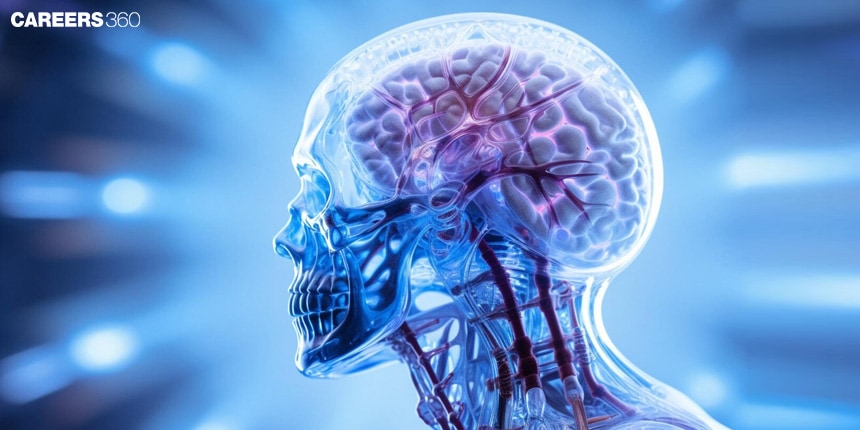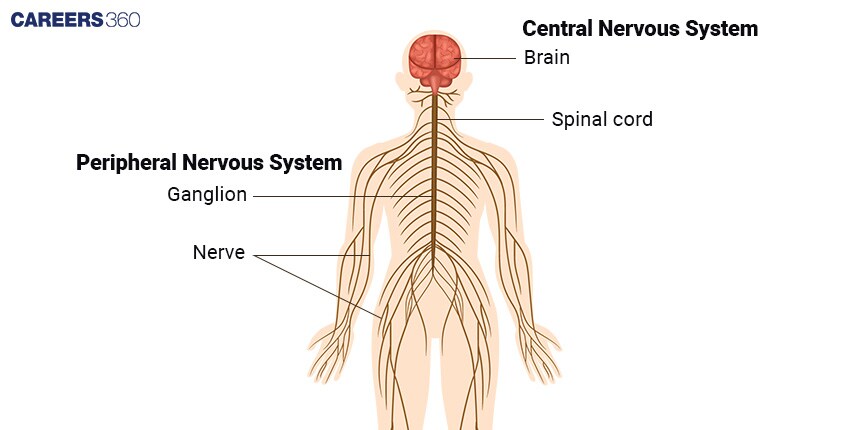Human Nervous System: Description, Development, Structure, Function, Diagram
The human nervous system is a complex network that coordinates and controls body functions. It consists of the central nervous system (CNS), including the brain and spinal cord, and the peripheral nervous system (PNS), which connects the CNS to the rest of the body. In this article, nervous system, structure of the nervous system, neurons, functions of the nervous system, and disorders of the nervous system are discussed. Human Nervous System is a topic of the chapter Neural Control And Coordination in Biology.
- What Is the Nervous System?
- Structure of the Nervous System
- Neurons
- Functions of the Nervous System
- Disorders of the Nervous System

What Is the Nervous System?
The nervous system utilises a complicated web of nerves and cells that convey messages to and from the brain and spinal cord down to various parts of the body. It is responsible for nearly every operation going on in the human body and the maintenance of homeostasis by its reactions to internal and external stimuli.
Structure of the Nervous System
The nervous system is foremost divided into the Central Nervous System and the Peripheral Nervous System.
Central Nervous System (CNS)
The parts of CNS include:
Brain
The brain is that part of the nervous system which forms the central organ controlling various functions and processes as a whole.
Lobes of the Cerebrum
Frontal Lobe: It is related to decision-making, problem-solving, and planning.
Parietal Lobe: It processes sensory information like touch, temperature, pain, etc.
Temporal Lobe: concerned with hearing processing and memory.
Occipital Lobe: It controls such visual processing.
Role and Importance
Each lobe has some special roles in the process of cognition, sensory processing, and motor control.
It regulates any vital life process: the brainstem controls heartbeat, breathing rate, sleeping, and waking up.
Cerebellum: Coordination And Equilibrium
It provides for smooth, coordinated muscle action and maintains balance.
Spinal Cord
The spinal cord is another major component of the CNS and acts as a connecting link between the brain and the rest of the body. Moreover, it enables reflex actions to take place.
Structure of the Spinal Cord
Nerve fibres ensure that there are signals both toward and away from the brain.
A reflex arc includes sensory neurons, interneurons, and motor neurons that give rise to quick, involuntary responses to stimuli.
Peripheral Nervous System (PNS)
It is divided into two parts:
Somatic Nervous System
Controls voluntary movements by transmitting signals to skeletal muscles.
The PNS relays information between the CNS and limbs/organ systems, so it's indispensable for the body's functioning and movements.
Structure and Function of Nerves
Nerves are bundles of axons that transmit signals between the CNS and the body.
Cranial Nerves
Twelve pairs of nerves arise directly from the brain, each with specific sensory or motor functions.
Spinal Nerves
Thirty-one pairs of nerves emerge from the spinal cord, transmitting signals to and from the body.
Autonomic Nervous System (ANS)
The ANS controls involuntary body functions, which it regulates with necessary physiological processes.
Sympathetic vs. Parasympathetic Systems
Sympathetic Nervous System: A help system that turns on your body when under stress or during an emergency.
Parasympathetic Nervous System: Calms the body and saves energy after stress.
Functions And Effects On The Body
The sympathetic nervous system accelerates this rate of the heartbeat, dilates pupils, and inhibits digestion.
The parasympathetic nervous system will slow the heart rate, constrict the pupils, and prompt digestion.

Also Read-
- MCQ practice on the Human Nervous System
- Neural Control And Coordination
- Control and Coordination
- Central Nervous System
Neurons
They are the basic units of the nervous system that convey information throughout the body.
Structure of Neurons
Cell Body (Soma): It contains a nucleus surrounded by usual organelles.
Dendrites: The far ends of the dendrites receive signals from other neurons and conduct these towards the cell body.
Axon: The axon conducts electrical impulses away from the cell body.
Myelin Sheath: The sheath covering the axon that insulates it and increases the speed of transmission of the signal.
Classification of Neurons
Sensory Neurons: They carry information from sensory receptors to the CNS.
Motor Neurons: They carry commands from the CNS to muscles and glands.
Interneurons: These connect the sensory and motor neurons within the CNS.
Synapse and Neurotransmitters
Synapse: This is the junction between two neurons.
The ending of one neuron releases neurotransmitters, which carry the signal.

Functions of the Nervous System
The nervous system has important functions, including:
Sensory Input
Sense changes in the environment with the help of sensory receptors.
Integration
Process and interpret sensory information to make decisions.
Motor Output
Generate responses by activating muscles and glands.
Disorders of the Nervous System
Several disorders may occur within the nervous system and may trigger critical health concerns.
Alzheimer's Disease
Memory loss, confusion, and cognitive decline.
Deposits of amyloid plaques and neurofibrillary tangles within the brain.
Medications to alleviate symptoms, and supportive care.
Parkinson's Disease
Tremors, rigidity, and problems with balance and coordination
Prospective loss of dopamine-producing neurons in the brain
Medications aimed at increasing dopamine levels; physical therapy.
Epilepsy
Recurrent seizures of variable intensity and type
Abnormal electrical activity within the brain.
Anti-seizure medications; surgery in some cases.
Multiple Sclerosis
Fatigue, muscle weakness, coordination and balance difficulty
Immune system attacking the myelin sheath of neurons.
Immunosuppressive drugs, physical therapy.
Also Read-
Recommended Video on the Human Nervous System
Frequently Asked Questions (FAQs)
This system detects and processes sensory input and it produces motor output that controls muscle and gland activity in the coordination of the activity of the body.
Neurons communicate via electrical impulses and chemical signalling. An action potential will travel down the axon to the synapse; there, neurotransmitters are released into the synapse and transmit this signal across to the following neuron.
The brain and the spinal column comprise the central nervous system. It interprets nerve impulses and processes the information. All the nerves not contained within the CNS make up the peripheral nervous system. These nerves help the body to connect with and communicate back to, the CNS.
The ANS controls involuntary activities, as in the case of heartbeats and digestion. Further, it is divided into the Sympathetic System, responsible for the 'fight or flight' responses, and the Parasympathetic System, responsible for 'rest and digest' activities.
The common diseases treated in this area include Alzheimer's, Parkinson's disease, epilepsy, and multiple sclerosis. Treatments usually involve medication, physical therapy, and schemes of supportive care to help the patient with his/her symptoms.
Also Read
30 Nov'24 10:55 AM
29 Nov'24 08:48 PM
29 Nov'24 06:52 PM
29 Nov'24 05:35 PM